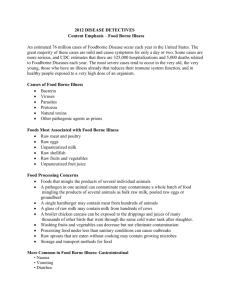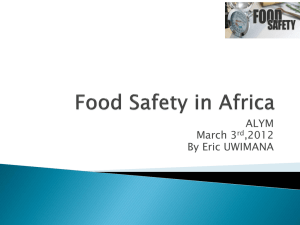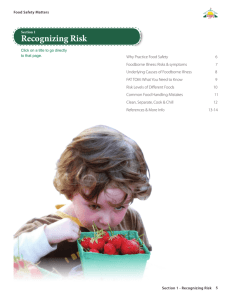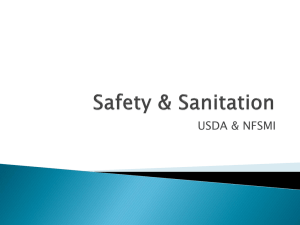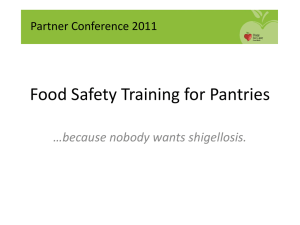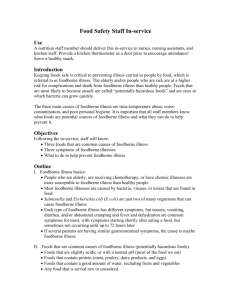Food Safety
advertisement
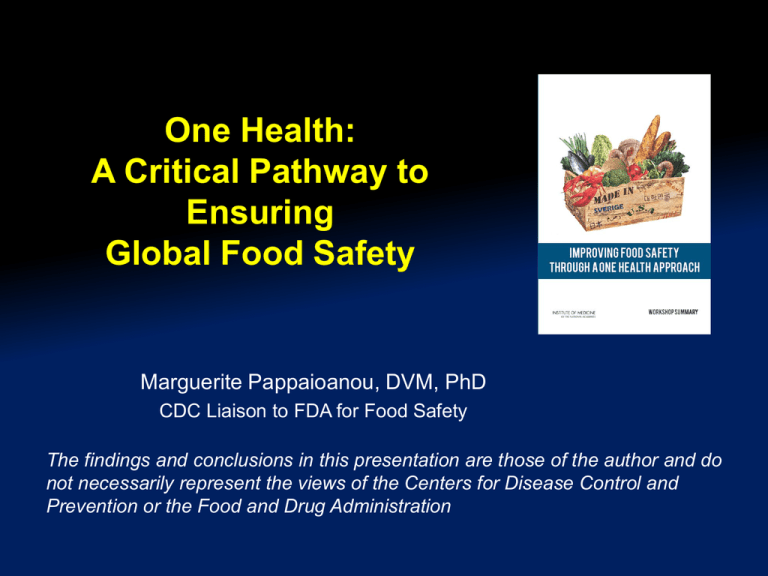
One Health: A Critical Pathway to Ensuring Global Food Safety Marguerite Pappaioanou, DVM, PhD CDC Liaison to FDA for Food Safety The findings and conclusions in this presentation are those of the author and do not necessarily represent the views of the Centers for Disease Control and Prevention or the Food and Drug Administration Several Current Complex Health Problems Feeding 7 billion people (and growing numbers) with nutritious, accessible, affordable food Impacts of climate change Floods, droughts Changes in reservoir hosts, vectors of disease Natural and human-made disasters Urbanization; Land Use and Agricultural Practice Changes Access to clean air and drinking water Non-communicable diseases Poverty Biodiversity Risk of emerging infectious diseases, pandemics Why One Health? Health problems today are complex; caused by multiple drivers, factors No single discipline or sector can do it alone Opportunities for prevention, mitigation along a continuum– multiple sectors and disciplines essential to solutions One Health Is the Collaborative Effort of Multiple Disciplines – working locally, nationally, and globally– to attain optimal health for people, animals, and our environment. AVMA-AMA One Health Task Force Implementing One Health Policies Impacting on drivers, process, outcome, impact; resource allocation, communications Multisectoral /disciplinary health programs Providers/treatment/care Disease prevention, surveillance, response, control, treatment Multisectoral/disciplinary Research Multi/Inter Professional Education Why Implement One-Health ? Achieve improved health for humans, animals, and the environment– all interconnected-- more effectively and efficiently More efficient use of limited resources Cost effectiveness of infrastructure to carry out prevention Achieve overall good for nation, region, world Opportunities for One Health Food Security Food Safety Emerging/ Zoonotic Diseases Bio- AgroTerrorism Emergency Response Biomedical Research Disability Antibiotic Resistance Mental Health Environmental Health Injuries Occupational Health Obesity Physical Activity Health Education Millenium Development Goals Source: UNDP Goal 8: Develop a Global Partnership for Development Food Security Exists “when all people at all times have access to sufficient, safe, nutritious food to maintain a healthy and active life”. Includes both physical and economic access to food that meets people's dietary needs and food preferences. Three pillars: Food availability: sufficient quantities of food available consistently. Food access: having sufficient resources to obtain appropriate foods for a nutritious diet. Food use: appropriate use based on knowledge of basic nutrition and care, as well as adequate water and sanitation. Food Security Globalization of the Food Supply Global Poultry Exports Air Routes Imported Foods and Entry Lines to the US Imported food entry lines has doubled 4.4 M in 2002 8.6 M in 2010 As of 2011, ~ 15% of all food products consumed in the US were imported 20% of fresh vegetables 50% of fresh fruit 80% of seafood Food Supply and Globalization Food Safety Assurance that food will not cause harm to the consumer when it is prepared and/or eaten according to its intended use (WHO). Causes of illness– contamination of food with bacteria, viruses, parasites toxins, metals, prions Symptoms range from mild to severe and life threatening Range of food related activities with respect to foodborne illness -- from prevention and surveillance to detection and control Ensuring Food Safety and Defense Surveillance Detection Assessing magnitude of the problem Outbreak investigation Response/mitigation Prevention Regulatory Systems Capacity Building Estimates of Burden of Foodborne Illness (Morbidity, Mortality, Economic Costs 2011 Estimates) Canada (32.5 M people) 1 in 8 Canadians (4 Million people) domestically acquired/yr Cost ~ $12-14 B annually The United States (300 M people) 1 in 6 Americans (48 M people) with foodborne illness ~ 128,000 hospitalized ~3,000 people die Cost ~ $77.7 B (individual costs) annually Globally (WHO) (7 B people) 1/3 of global population (2 billion people) 1.5 billion cases of diarrhea in children < 5 yrs/year, > 3 M premature deaths Scallan, et al, EID 2011; Thomas et al, Foodborne pathogens and disease 2013 International Costs of Foodborne Illness Loss of trade (commodities– produce, livestock, etc.) Loss of food Loss of tourism Public Health Surveillance costs Outbreak investigations Clean-up Global Food System – “Farm to Fork” Food production systems to feed growing human population at affordable cost (produce, nuts, meat, aquaculture, processed foods) Land, Water, Climate change Animal feed, fertilizers, pesticides, antibiotics? Markets – local, national, international, role of small holders, women Livestock housing, animal welfare considerations Genetics, genomics, seeds, animal and plant health, emerging food pathogens Transportation: To Processers, Distributers, Retailers, Food Stores, Marketing Agricultural investments Economic crises, Rising Food Prices, Political turmoil and unrest Supply chain risks How contamination of foods occurs Fields fertilized with untreated manure, watered with unclean water Animals fed contaminated feed Many bacteria– i.e., Salmonella spp., Campylobacter spp., Yersinia enterocolitica, E. coli STEC, can reside in healthy food animals showing no signs of illness. These animals can spread the bacteria to other healthy animals on the farm and during transportation to processing facilities During processing, the bacteria may cross-contaminate other foods being processed at the same location. Food is stored at too high a temperature and for too long Many different countries supply foods to other countries. Consumers should also be alert to the potential for crosscontamination in the home. Challenges for Food Safety Authorities Increasing burden of foodborne illness and new emerging foodborne hazards (healthy animals) Rapidly changing technologies in food production, processing and marketing Developing science-based food control systems with a focus on consumer protection International food trade and need for harmonization of food safety and quality standards Changes in lifestyles, including rapid urbanization Growing consumer awareness of food safety and quality issues and increasing demand for better information Source: Assuring Food Safety and Quality: Guidelines for strengthening national food control systems. FAO/WHO Publication Food Safety Challenges of Developing Countries Differ by region-- differences in income level, diets, local conditions, and government infrastructures. Food producer and the consumer often have a close connection. Fewer processed and packaged foods Most fresh food is traded in traditional markets; street vendors supply much of the food consumed outside the home. Perishable food often prepared and consumed immediately Minimal storage of prepared foods. Food Safety Concerns - Developing Countries Inappropriate use of agricultural chemicals Use of untreated or partially treated wastewater Use of sewage or animal manure on crops Absence of food inspection, including meat inspection Lack of infrastructure, such as adequate refrigeration Poor hygiene, including a lack of clean water supplies Roles and Responsibilities-Surveillance, Outbreak Investigation, Mitigation/Response, Regulatory Systems, Prevention Food Safety Non-Regulatory Agencies (U.S.) HHS/Centers for Disease Control and Prevention Foodborne illness surveillance– PulseNet, FoodNET, FoodCORE, National Outbreak Reporting System (NORS), National Antimicrobial Resistance Monitoring System (NARMS), Foodborne Outbreak Online Database (FOOD) Epidemiologic outbreak investigations, special studies on attribution, outbreaks EHS-NET (food service establishments, NVEAIS) Integrated Food Safety Centers of Excellence USDA/Animal and Plant Health Inspection Service, Veterinary Services On the farm food animal disease surveillance, prevention, control Food Safety-- Regulatory Agencies (U.S.) HHS/Food and Drug Administration (produce, dairy, eggs, seafood) Regulations, MFRPS, Food Code Compliance and enforcement Facility / Food service inspections, investigations Tracebacks, trace-forwards Sampling and testing foods Environmental assessments Root cause analyses, industry relations Regulatory science Subject matter experts, relationships with industry Food defense Rapid Response Teams USDA/Food Safety and Inspection Service (meat) Tools to Stop Foodborne Outbreaks Trace back and trace forward– food vehicles Communications/sharing information/alerting consumers Inspections, sampling, testing Voluntary Recall Mandatory Recall Food Detention Seizure Administrative warning letter Import alerts Injunction Criminal Prosecution Preventing Foodborne Outbreaks Healthy animals and crops Sanitation, clean facilities, equipment Safe agricultural/food production practices, safe food processing Best practices / Educating restaurant managers, food workers, grocers on food safety and sanitation measures Educating consumers, proper food handling at home, hand washing, cooking Public/private sector partnerships Evidence-based, strong regulatory systems Capacity Building Farm-to-Table Prevention Production Processing Preparation and Cooking Farmers, Industry, Fishermen, University Extension, Engineers, Sanitarians, Veterinarians Food industry, Food Scientists, FSIS and FDA (SME, food inspectors, consumer safety officers, compliance officers), State agriculture Grocers, restaurant owners, food handlers/preparers, home cooks, preparers, FDA, City/County, State Government Food Safety Legislation - US Federal Food, Drug, Cosmetic Act (1938) Food Safety Modernization Act (FSMA) (2011) Recognizes primary responsibility and capacity of food industry to make food safe • What the food industry does every day– producers, distributors, suppliers • Highlights need for gov’t collaboration with food industry in getting standards right and providing assurances that standards are met Spells out essential and complementary role of government Government, Industry Collaboration Key to Success FDA’s International Food Safety Capacity Building Plan (FSMA- 305) • Enhance efficiency across FDA/FVM Program • Increase effectiveness through evidence-based decision making • Support exchange of information between FDA and foreign government agencies or other entities • Enhance technical assistance and capacity building in food safety INTERNATIONAL ORGANIZATION, ORGANIZATIONS FOR FOOD SAFETY International Organizations – Food Safety FAO, WHO, OIE Codex Alimentarius World Trade Organization International Organization for Standardization (ISO) Alliance for Food Security and Nutrition (G8) Ministries of Health, Agriculture, Commerce Academia/ Universities – Research, training, extension Parastatal organizations– NAS/IOM/NRC (US) Associations -- Not for profit and for profit Pew Charitable Trust, Center for Science in the Public Interest, Institute for Food Technologists, International Association for Food Protection Global Food Safety Initiative Food producers, processors, retail market WHO Department of Food Safety and Zoonoses Provides evidence-based scientific options for policy development to protect consumer's health and managing food safety Develops mitigation strategies to prevent, control and contain risks Sets international standards and promotes their implementation Coordinates international efforts to food-related outbreak surveillance, detection and response Ensures clear risk communication in support of foodborne and zoonotic disease prevention Provides technical support to assist Member States building sustainable capacity. WHO Global Foodborne Infections Network (GFN) • Capacity-building program • Promotes integrated, laboratory-based surveillance • Promotes intersectoral collaboration among human health, veterinary and food-related disciplines • 184 Member States and territories; 1062 members FAO Achieving food security for all Ensure regular access to high-quality food for active, healthy lives. Improve nutrition, increase agricultural productivity, raise the standard of living in rural populations Contribute to global economic growth. 194 Member Nations, two associate members and one member organization, the European Union. Headquarters - Rome Codex Alimentarius Commission Established by FAO and WHO in 1963 Develops harmonized international food standards, guidelines and codes of practice to protect the health of the consumers and ensure fair practices in the food trade. Promotes coordination of all food standards work undertaken by international governmental and nongovernmental organizations 185 Member Countries and 1 Member Organization (EU) 220 observers– 50 IGOs, 154 NGOs, 16 UN Committees, Task Forces CODEX Standards Codes of Practice (46) Guidelines (69) Maximum Residue Limits (MRLs) Standards (330) OIE- World Organization for Animal Health Intergovernmental organization responsible for improving animal health worldwide (est. 1924). In 2013 -- total of 178 Member Countries Maintains permanent relations with 45 other international & regional organizations; has Regional and sub-regional Offices on every continent. Reference organization of the WTO Sanitary Phyto-Sanitary Standards Establishes standards (Terrestrial- ; Aquatic Animal Codes, Biological standards, etc.; veterinary services, competencies) 2002-- Established permanent Working Group on Animal Production Food Safety (APFSWG) Membership includes internationally recognized experts from FAO, WHO, Codex Alimentarius Commission (CAC), reflects a broad geographical basis. World Trade Organization Organization for trade opening Forum for governments to negotiate trade agreements Operates a system of trade rules Place for governments to settle trade disputes. Place where member governments try to sort out the trade problems they face with each other. Established 1995 159 countries WTO Agreements Organization of International Foodborne/FoodSafety Surveillance Looking to the Future Globalization -- Domestic IS Global; export and import of foods will only increase Food Security, Food Safety, Food Defense Antibiotic Resistance, Food producing animal – welfare Impacts of Climate Change Public-private sector collaboration Need for Strong Regulatory Systems – all countries Capacity Building – Applied epidemiology, laboratory methods (whole genome sequencing, culture independent methods), regulatory science/systems One Health! Multi-Disciplinary Teams– Disciplines, Sectors • Food Scientists • • Environmental Health • Specialists/Engineers • Public health nurses • • Physicians • • Microbiologists, Toxicologists • Epidemiologists • • Veterinarians • Consumer Safety Officers • • Food and Drug Investigators/inspectors • Biostatistitians • • Public Health Educators • Information/communication officers • Legal/lawyers Health sector; National reference laboratories; Agriculture, fisheries; Food/feed safety sectors; Local authorities; Sectors that liaise with industry, trade and academia Other agencies One Health Core Competencies Building on technical skills and knowledge of individual disciplines, sectors • Systems analysis/thinking (understanding bigger picture, determinants of illness/disease/health, how multiple sectors are involved) • Strong leadership and management skills • Understanding self-limitations and need for experts from different fields • Teams and teamwork- Understanding roles and responsibilities • Communication for collaboration • Conflict resolution • Values and ethics • Creating an enabling environment and advocating change One Health Education for a One Health Workforce POLICIES that Create Enabling Environments and Resources RESEARCH AND EVALUATION PRACTICE/PERFORMANCE EDUCATION What is Practiced in any Setting What is Learned and Taught Adapted from D’Amour D. & Oandasan I. 2005. J Interprofessional Care Suppl. 1:820. And further enhancements by Tufts University and DAI, Inc. of the USAID/Respond Project • • • • • • • Prevention Early detection/DX Early effective response/mitigation Stop/control transmission Effective treatment, care Efficient use of limited resources Better Health and Well-Being Thank you Questions? Comments? The findings and conclusions in this presentation are those of the author and do not necessarily represent the views of the Centers for Disease Control and Prevention




